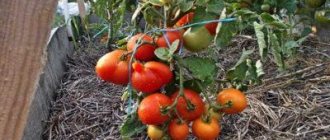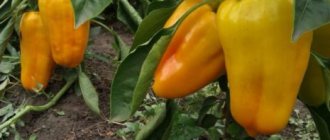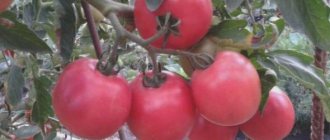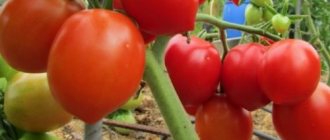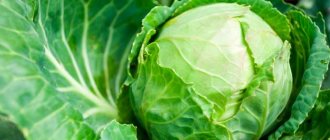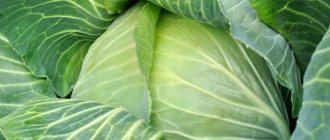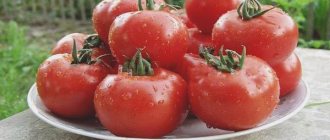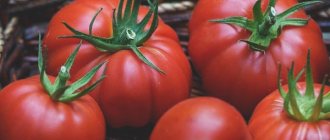General characteristics of the plant
The Kalinka-Malinka tomato bush is classified as a super-determinate type.
Compact standard varieties are convenient due to their small size: they can be planted in the garden, in a greenhouse or film shelter, and you can also grow homemade tomatoes on the balcony or directly on the windowsill. The average stem height is only 25-30 cm; the bushes do not need tying or shaping. The root system is not very developed. This advantage makes compact planting possible (up to 6-8 bushes per 1 m²). Tomatoes bear fruit well even in a limited area.
Characteristics and descriptions of the variety by vegetable growers note that the tomatoes are undemanding to care and do not cause any trouble to the owners. Mini tomatoes only need to be earthed up about 1 week after planting, and do not forget to water them on time if they are growing in a container on the balcony. But for Kalinka-Malinka tomatoes, even slight drying out of the soil is not a problem. In open ground, plants can bear fruit well even in the conditions of the Urals, Altai and Siberia.
A bed of such tomatoes is also convenient because in the event of an unexpected cold snap, it can be quickly covered with film or lutrasil. The compactness of the bushes allows you to plant several groups of tomatoes. The vegetable grower will be able to receive products at different times, starting from the earliest at the beginning of summer.
Reviews from gardeners agree that it is irrational to take up space in a greenhouse with such varieties. But mini-bushes of Kalinka-Malinka tomatoes can be planted, alternating them with tall varieties with long-term fruiting. Having received an early harvest of Kalinka-Malinka, the bushes that have completed the growing season are removed.
The yield of the variety is 2.5-4 kg per 1 m² and depends on the density of planting. The minimum distance between them is 30 cm.
General information, description
The Kalinka-Malinka tomato is the work of breeders of the Novosibirsk agricultural company Siberian Garden. In 2007, the variety was approved by the State Register of the Russian Federation for cultivation in all agricultural regions of the country. The originator recommended the tomato for planting in open ground. In practice, summer residents successfully cultivate it in stationary greenhouses, high or low greenhouses, containers on loggias or balconies.
Peas: varieties and growing characteristics
The variety got its name thanks to its medium-sized fruits. Inside they are tender, sugary, not too dense. The taste is excellent. Tomatoes are tied in tassels of 4-6 pieces.
The bush itself is also low, standard. In rare cases it grows up to 70 cm, usually lower. The leaf is dark and medium in size. Due to its compactness and small fruit, one tomato bush produces a relatively small harvest per season. But the plant does not reduce productivity in case of unfavorable weather or poor quality care.
Attention! Gardeners have dubbed the tomato a variety for the lazy.
Characteristics and description of the tomato variety “Kalinka-Malinka”
This variety of tomatoes appeared relatively recently, but has already become a favorite among gardeners. This is a mid-season super-determinate tomato variety. It does not have F1 generation hybrids.
Suitable for growing:
- in open (unprotected) ground;
- under film (spunbond or other material);
- in the greenhouse.
Like any variety of tomatoes, the Kalinka-Malinka tomato has its own advantages, among which the main ones can be identified:
- tomatoes have good keeping quality;
- compact bushes;
- do not require special care;
- versatility of use;
- disease resistance;
- can be grown both in a greenhouse and in open ground;
- the fruits have a marketable appearance.
Watch the video! Tomato variety Kalinka-Malinka
The Kalinka-Malinka variety was developed by Russian breeders in the 21st century. The tomato is included in the State Register of Russia for use in unprotected soil on private farms.
The tomato variety “Kalinka-Malinka” has the following positive qualities:
- Ease of growing;
- Good yield;
- The versatility of the purpose of the fruit;
- Excellent taste characteristics;
- Immunity to diseases typical of nightshades;
- Capable of long-term transportation.
No significant deficiencies have been identified in the variety.
To grow the Kalinka-Malinka variety, the standard seedling method is used.
Basic recommendations for preparing seed material:
- Pre-sowing calibration of seeds is carried out by soaking them in a saline solution. Floating specimens are rejected;
- Before sowing, the seed material is treated in a weak manganese solution or in a baking soda solution;
- To accelerate the emergence of seedlings and the subsequent formation of ovaries, a special growth stimulator “Epin” is used. The seed material is placed in a gauze bag and left in the stimulator for two to three hours.
How to sow seeds for seedlings:
- Seed material is sown for seedlings 50-60 days before the expected date of planting the plant in a permanent place;
- You can sow in either purchased soil or prepared soil yourself, which should contain peat, humus and sand in equal proportions;
- The seed material is buried 1-2 cm into the soil, watered abundantly and covered with film. Containers with seedlings are placed in a well-lit place, with a temperature range of 23 to 24 ºС. This temperature is optimal for rapid germination of seedlings;
- After the first shoots appear, the film is removed;
- During the growth period, seedlings must be provided with moderate watering with warm water and fertilized using mineral and organic fertilizers. Also, do not forget about loosening the soil;
- After the first three true leaves appear, the young seedlings dive. For this purpose, separate pots are first prepared;
- 10-14 days before the planned planting in a permanent place, the seedlings are hardened off;
- Tomato seedlings ready for planting in unprotected soil should have a strong stem and one inflorescence on the racemes.
How to plant seedlings correctly:
- Young seedlings are planted at different times. In greenhouse structures, when planted in mid-May, the harvest can be harvested in mid-June. Planting in unprotected soil is carried out only in early June, after the danger of returning night frosts has passed. They are planted in greenhouses between the first two methods, since young seedlings are not afraid of possible frosts, but in mid-May the tomato bushes will not be warm enough under a film cover;
- The bushes are placed at intervals of 25 cm from each other, the row spacing should be 40 cm.
It is optimal to plant no more than five seedlings per 1 m2.
Seedling care
You can get strong seedlings only if you provide proper care for them. Particular attention should be paid to the following activities:
- Watering. Plants need to be watered in a timely manner; for this you can only use warm water.
- Feeding. Be sure to add mineral and organic compounds.
- Loosening. The soil must be in a loose state.
- Picking. As soon as the seedlings have the first 3 leaves, you can start picking. To do this, you should prepare separate containers in advance.
My secret || Winter apple tree phoenix. Altai phoenix apple tree - description of the variety Phoenix apple tree || || Altai phoenix
Application
Kalinka-Malinka tomatoes are classified as universal varieties. The fruits have a sweet and sour taste and are good for fresh consumption and for preparing vegetable salad. Small tomatoes will decorate the holiday table, as canapés and slices. Tomatoes are used to produce juices, sauces, and seasoning soups.
The first ripe tomatoes will begin to appear 110 days after sowing the seeds. Despite the compactness of the bush, reviews from those who planted this variety note the rather large size of the tomatoes. The average weight of 1 fruit is 50-90 g, and its diameter is about 4 cm. Round red berries are collected in complex clusters of 6-7 pieces, and the small plant seems completely covered with them.
The skin is dense and does not crack when tomatoes ripen and are heat treated during canning. Tomatoes tolerate transportation well over long distances. The fruits of Kalinka-Malinka can be stored for several days in a fully ripe form, without showing signs of spoilage. Reviews from gardeners indicate that unripe fruits ripen well when picked, and their taste does not suffer.
The pulp is intensely colored, the fruit has 2 seed chambers with many grains. The walls of the berry are thick, up to 1 cm. The consistency of the pulp is dense; when unripe, it can have a slight crunch. When canning, the structure of the fruit does not change, it retains its shape well, and the tomato can be cut with a knife.
The purpose of Kalinka-Malinka tomatoes is universal. Tomatoes are delicious fresh; their sweet, sour, aromatic berries complement any vegetable salad well. You can also decorate a holiday table with miniature tomatoes, using them for canapés and slices. Any dishes can be prepared from red tomatoes, because the bright pulp will color sauces and soups well.
You can preserve surplus products in any way. Small calibrated tomatoes are convenient for whole-fruit pickling or pickling. They can be processed into juice or sauces if there is a large harvest of such fruits. The dense structure of the pulp allows the Malinka tomato to be used for drying. You can even make exotic jam from unripe berries.
Appearance and characteristics of tomatoes from the “Raspberry Miracle” series
Each variety of Raspberry Miracle tomatoes has its own characteristics:
- Crimson sunset. Early ripening plant. In greenhouse conditions it can reach 2 meters in height. The fruit has a round shape, its weight is about 340 g. Productivity is about 12 kg per 1 m2.
- Raspberries. Mid-season variety. The bush is about 60 cm in height. The fruits are large, round in shape, the average weight of which is about 400 g. The yield is high - about 11–13 kg per 1 m2.
- Bright robin. Early ripening variety. Grows up to 1 m in height. Productivity is high - 12–14 kg per 1 m2. The fruits are large (about 400 g), round.
- Raspberry paradise. Mid-season tomato with very large fruits (about 500 g). Bush - up to 1 m in height. Productivity - 10–12 kg per 1 m2.
- Raspberry wine. In terms of characteristics and description, this variety is similar to the Bright Robin. But the fruits are not so large. On average, their weight is about 300–400 g.
- Raspberry joy. Early ripening variety. The bush is 90–100 cm high. The fruits are not very large (about 100–130 g), but grow in large clusters. This feature allows us to consider Raspberry Joy a high-yielding variety. The yield is about 14 kg per 1 m2. Tomatoes are shaped like eggs.
- Raspberry bison. Mid-early variety. Limited in growth to a size of up to 1 m. The fruits are round, weighing about 350 g. Productivity per 1 m2 is about 12 kg.
- Raspberry dream. An early-ripening plant with large (about 400 g) fruits of a round, slightly flattened shape. High-yielding variety (12–14 kg per 1 m2). The height of the bush is up to 1 m.
- Raspberry King. Mid-early. Bush up to 1 m in height. It is characterized by the uniformity of the fruit, the average weight of which is about 300–350 g. The shape is flat-round. Productivity - 10–11 kg per 1 m2.
- Raspberry desirable. A mid-early plant with flat-round fruits. Their weight is about 400 g. The yield is about 13 kg per 1 m2.
- Raspberry popsicle. Mid-early variety. The fruits are round, weighing about 300 g. The bush grows up to 90 cm. It has good tolerance to adverse weather conditions: even during prolonged rains it is very resistant to fungal diseases. Productivity is high. About 14 kg per 1 m2.
- Raspberry heart. Mid-early variety. The fruits weigh about 300 g and are heart-shaped. Productivity per 1 m2 is about 13 kg. It has excellent taste. Bushes - up to 80 cm in height.
- Raspberry bunny. Early ripening variety. Bush up to 100 cm. The weight of one fruit is about 350 g, and the yield is 11–12 kg per 1 m2. It tolerates temperature fluctuations well and produces a large harvest even in cool weather.
- Raspberry hero. Mid-early tomato. The fruit is large (about 480 g), slightly flattened and round in shape. The yield is high, about 15.5 kg per 1 m2. Bush up to 1 m in height. Resistant to cracking.
- Raspberry surprise. An early-ripening plant with flat-round fruits weighing about 350 g. From 1 m2 you can harvest about 14 kg of tomatoes. The bushes reach a height of about 90 cm.
How to grow a variety on a plot?
When growing seedlings, you need to take into account the sowing time: early ripening tomatoes are sown no earlier than 50-60 days before transplanting to a permanent place. Soil for sowing is prepared from equal parts of fertile soil, sand and humus, adding 2 tbsp. l. ground chalk for every 10 kg of mixture. To disinfect the soil, directly in the box, generously water it with a hot dark solution of potassium permanganate.
The variety is not hybrid (F1). If seeds for reproduction are prepared independently, then they also need to be processed before sowing. For soaking, you can prepare a solution of Fitosporin-M, Epin, or disinfect it with a light pink solution of potassium permanganate. Liquid temperature 35°C, holding time – 30-40 minutes. After processing, dry the seeds on paper or gauze.
The soil for sowing will have cooled down by this time. You can begin to spread the seeds over the surface of the substrate. Cover the grains with a thin layer of dry sand or soil (0.5 cm), cover the box with film with holes and place it in a warm place (25°C). Shoots appear in 4-5 days, but with cooling this period may increase.
You can plant on the site at different times:
- transplanted into the greenhouse in mid-May, starting to harvest in mid-June;
- can be planted on the beds only in early June, after the end of frost;
- They are planted in a greenhouse between the first 2 methods, since the plants are not in danger of dying from frost, but in mid-May it is not warm enough under the film.
When combining these options, you can get a harvest from mid-June to about mid-July.
It is best to grow in seedlings. Before planting, the seeds are treated with any growth stimulant (for example, Epin).
Seeds germinate well at temperatures from 23 to 25 degrees. They are usually sown in March, 60 days before planting in the main place. Caring for seedlings is simple: watering with settled water, loosening, picking.
When planting seedlings in the main place, use the following plant placement scheme:
- from 40 cm between rows;
- from 25-30 cm between tomatoes in a row.
Plants are planted up to 6-8 pcs. per one square meter. The bushes are low, it is convenient to grow them on the balcony in containers or in tubs on the site. If grown in open ground, when it gets colder they can easily be covered with spunbond or film.
10-12 days after planting, the plant stems are earthed up. It is better to mulch the surface of the ground (cover it with mowed grass).
There is no need to pin this variety of tomatoes (remove shoots between the stem and leaves). This feature makes Kalinka-Malinka a very easy variety to cultivate.
Tomatoes are watered regularly, not necessarily abundantly. This simple rule will help the bush grow compact.
The good thing about miniature tomato bushes is that they are suitable for growing not only in open ground or greenhouses, but you can also get harvests in mini-gardens on windowsills and balconies. Varieties such as Kalinka-Malinka serve as an element of site design when they are planted in tubs and pots.
Vegetable cultivation begins by planting tomatoes as seedlings. Depending on climatic conditions, sowing is carried out from March to April. Before planting tomato seeds in the ground, they are placed in a one percent solution of potassium permanganate or baking soda. The growth stimulator Epin will speed up seed germination. Planting material is dipped into it in a gauze bag for two to three hours.
The seeds are buried one to two centimeters into the soil, watered abundantly and then the boxes with seedlings are placed in a bright place where the air temperature reaches 25 degrees above zero. It remains to properly care for the Kalinka-Malinka tomato seedlings:
- water moderately with warm water;
- feed with mineral and organic fertilizers;
- loosen the soil in the container;
- pick up seedlings by transferring them into separate pots.
Tomato bushes of the Malinka variety, ready for transplanting into open ground, should have a strong stem, with one inflorescence on the racemes.
Diseases and pests
The tomato variety “Kalinka-Malinka” is rarely exposed to various diseases because it has good immunity. However, if this does happen, the plant is treated using special fungicidal preparations. Preventive treatment of plantings with insecticides will help prevent the appearance of insect pests in the garden.
Kalinka-raspberry exhibits high resistance to diseases. It is rarely affected by late blight.
If there are pests in the garden or garden, “fragrant” spraying is carried out to prevent infection of tomatoes. The pungent odor will repel aphids and caterpillars that feed on plant juices.
Examples of compositions:
- Garlic tincture. It is prepared by infusing 250 g of garlic in four to five liters of water for several hours. The solution is sprayed onto tomato leaves.
- Tobacco solution. It is prepared from five liters of hot water and 200 g of chopped tobacco. Leave for 24 hours. After filtering, the bushes are sprayed.
If folk remedies are powerless and infection still occurs, insecticides such as Aktarin or Karbofos will help. Dosage - according to the manufacturer's instructions.
Let's sum it up
The tomato variety “Kalinka-Malinka” does not require much care, which is why it is loved by Russian tomato growers. The basic rule of growing is regular watering. There is no need to tie or pin. The bushes are compact, low, and practically do not branch. They can be planted more densely. Even from a small garden bed a significant harvest is harvested.
Anyone who loves tomatoes, but doesn’t want to bother growing them, will certainly choose the Malinka tomato. After all, a super-determinate variety has many advantages, even though it does not belong to the first generation F1 hybrids. The very name of the tomato – Kalinka-Malinka – suggests that growing the vegetable is a pleasure.
Advantages of the variety
The description of the Kalinka-Malinka tomato variety includes characteristics of the fruit and the plant itself. The vegetable belongs to the standard tomato varieties. This means that the bush reaches about twenty-five centimeters in height. But despite this, the popularity of the plant is great. Tomato bushes are compact and have almost no branches. And the weakness of the root system allows them to be grown closer to each other. Therefore, even a small plot or a small greenhouse can accommodate a lot of tomato bushes.
The characteristics of fruits consist of such parameters as:
- roundness of shape;
- density, smoothness of the skin;
- high level of dry matter;
- minimum seeds in two or three nests;
- tomato weight is fifty to ninety grams;
- excellent taste;
- excellent keeping quality of tomatoes.
Red fruits ripen 110-115 days after planting the seeds. And the tomato yield is more than two and a half kilograms of tomatoes per square meter.
Flame Agro – variety of Tomato plant
Information on the admission of Tomato Flame Agro from the Register of the State Variety Commission of the Russian Federation
Application for admission No. 61740, registered 2013-10-29. The variety Tomato Flame Agro was included in the register of those approved in 2015. Approved for use in regions: All regions.
The originators of the Tomato Flame Agro variety are:
- AGROFIRM POISK LLC (140153, MOSCOW REGION, RAMENSKY DISTRICT, VEREYA DISTRICT, BUILDING 501)
- FEDERAL RESEARCH CENTER FOR VEGETABLE GROWING (143080, MOSCOW REGION, ODINCOVSKY DISTRICT, VNIISSOK VILLAGE, SELECTSIONNAYA STREET, 14)
Other varieties of tomato plant
Question to the portal experts
If you haven't found the answer to a question, don't hesitate to ask an expert.
Register or Login so you don't have to enter your Name and Email every time
Thanks for the comment! It will be published after checking by a moderator!
No comments yet, be the first!
A portal for those who love their dacha
Your question has been sent for moderation. Don't worry, we quickly check your questions and your question will be answered within 1 day.
We have noticed that you are already registered on our website. We recommend that you log in to view the created question.
If you don't remember your password, you can recover it.
You were not registered until today, so we have registered you. Your password has been sent to your specified mailbox.
Help our site develop!
Please read this message, it will not take up much of your time!
We so need your comments and questions to understand in which direction we should develop.
Don't forget to leave a comment if you found what you were looking for. And if you haven’t found it, use the “Ask an Expert” form in the site header. We will answer this question, and other visitors will be able to find the information that you could not find.
Your question has been sent for moderation. Don't worry, we quickly check your questions and your question will be answered within 1 day.
We have noticed that you are already registered on our website. We recommend that you log in to view the created question.
If you don't remember your password, you can recover it.
You were not registered until today, so we have registered you. Your password has been sent to your specified mailbox.
Planting and care
A characteristic feature of the variety is its unpretentiousness in care. However, to get an excellent harvest, you just need to follow these recommendations:
- Tying and pinching need not be carried out;
- Fertilize three to four times a season using organic and mineral fertilizers;
- Water the plantings regularly, but moderately;
- Since, due to their short stature, tomato bushes suffer from scorching sun rays, they must be covered with spandball;
- Mulching will help protect the crop from drought, reliably retaining the necessary moisture. Hay and straw are good for mulching.
ATTENTION: Start mulching as soon as the soil warms up well.
The survival rate of low-growing plants is much better than their tall counterparts. The peculiarity of planting a standard is that such tomatoes can be planted more often than conventional varieties. Five plants are placed on one square meter at a distance of twenty-five centimeters from each other. And between the rows a gap of forty centimeters will be enough.
The peculiarity of growing Kalinka-Malinka tomatoes is that they are not needed:
- tie up;
- feed heavily;
- pinch;
- water frequently.
Under such conditions, the bushes will be neat, miniature, compact. They are not able to break from gusts of strong wind or heavy rain. To save low-growing tomato bushes from the soil-drying heat, the plantings must be mulched. Hay, straw, and pine needles are used as mulch material. Lay out the selected material in a layer of six to eight centimeters after watering so that the root collar remains free.
Low-growing tomatoes can be damaged by bright sunlight, so they need to be covered with a special protective material - spandball. It is better to refresh plants under cover with warm water from a watering can.
Since the leaves of the vegetable plant are active in relation to photosynthesis, the productivity of the tomato increases many times. Therefore, the Malinka variety is suitable for growing in fields. It’s no wonder that farmers’ reviews of planting and caring for low-growing tomatoes are excellent. They note that they are ideal for mechanized cultivation. And thanks to its resistance to cold and disease, the standard type of tomato ensures consistently high yields of tasty and juicy fruits.
To grow seedlings, use peat cups or other containers. A little rotted manure is added to the soil - no more than 1/3 of the volume of soil in the container. Sow seeds at the end of February. Before this, they must be soaked in warm water (20-25 0C) for 18 hours. Dried seeds are deepened 1 cm into the soil.
In mid-April, the plant can be planted in a greenhouse, and in open ground a few weeks later, when the threat of frost has passed. Seedlings are planted up to 5 pcs per 1 sq. m.
Note! The plant has a compact root system. If the plot is small or the greenhouse is small, you can plant many Malinka tomato bushes without fear of competition for space and food.
The plant is not too branchy, so there is no need to shoot it. Due to the fact that tomato fruits have a beautiful crimson color, they are planted in pots to decorate the garden.
Tomatoes in pots
The tomato needs regular watering with warm water in the morning or evening (once a week, 3-5 liters per bush). During the fruiting period - 2 times a week, 3-5 liters. for each bush. If you add a couple of pinches of ash to a bucket of water, such watering will strengthen the plant’s immunity and serve as an excellent fertilizer.
Important! It is imperative to loosen the soil as a crust forms on its surface.
Fertilizing with mineral or organic fertilizers should be applied 3 times per season. They can be alternated. Fertilizer is applied for the first time 3 weeks after planting in open ground. Subsequent feedings - every 2 weeks. To do this, you need to dissolve 15 grams in a bucket of water. ammonium nitrate, 50 gr. super phosphate and 30 gr. potassium You can use dry chicken manure in a proportion of 10 grams. for 10 liters of water. Add 0.5 liters of nutrient liquid to each bush.
Feeding tomato seedlings
So, if you decide to plant a Malinka tomato, the characteristics and description of the variety will help you get a good harvest. You can grow tomatoes of this variety not only to obtain a tasty harvest, but also as an ornamental plant. Caring for the plant is simple, so even a novice vegetable grower can handle it.
Tomatoes in pots
Tomato Kalinka-Malinka: reviews, photos, characteristics and description of the variety, which is presented in our article, is very popular among most gardeners. Next, let's talk about the characteristics, advantages and disadvantages of the variety. At the end of the article, you will be able to read reviews from those gardeners who have already planted the Kalinka-Malinka tomato variety on their plots.
Features of cultivation
Before planting seeds for seedlings, they must be treated with a weak solution of potassium permanganate. The land for planting also needs to be prepared accordingly. If the soil is purchased, then it does not require unnecessary preparatory steps, and if it is taken from the garden, then before planting it needs to be well calcined in the oven and cooled. For the best growth and development of plants, you need to fertilize the soil.
Seeds
The seeds are placed deep into the ground at a distance of 2-3 cm and the soil is slightly compacted. It is necessary to water the soil well and cover the containers with seedlings with cellophane. You need to put the boxes in a warm, dark place and wait for the first shoots for 2 weeks.
After the seeds germinate, the cellophane is removed and the boxes are placed on a bright windowsill. Now you need to monitor the soil moisture and avoid drying it out. After the first 2-3 leaves appear on the stems, you should start picking the seedlings and transplanting them into separate containers.
Seedling care
In this case, it is necessary to gradually accustom the seedlings to temperature changes, arrange ventilation of the room and take them out into open spaces on the street. After seven true leaves appear, the sprouts can be transplanted to a permanent garden location.
The soil in the garden is also pre-prepared for planting.
- They pound it well with a pitchfork;
- fertilize with minerals;
- the formed holes are spilled with plenty of warm, settled water and the plants are planted.
As the bushes develop, they are given some care. It is necessary to monitor the condition of the leaves of the plant and, if excess shoots appear, remove them immediately. In greenhouse conditions, the “Big Momma” variety requires regular ventilation of greenhouses.
It is necessary to water the seedlings as needed. During dry periods, frequent watering can be done. In cloudy and gloomy weather, watering should be reduced to 1-2 times a week.
The fruits ripen quite well, the first harvest is the richest, subsequent ones depend on proper care of the plant and its regular watering.
Did you like this variety?
Not really
What vegetable growers say about tomatoes
The Kalinka-Malinka variety became known to summer residents recently, but many choose it for its ease of care and note the rapid ripening of red, juicy fruits. Tomato pulp has a lot of dry matter and little water. Hence the use of the crop for pickling in its entirety, pickling, and drying.
Reviews about tomatoes contain information that low-growing bushes hardly get sick, they are not afraid of late blight, fusarium, and common fungal diseases. Gardeners also note that the plant is suitable for planting in open ground, in polycarbonate greenhouses. Beginning vegetable growers and farmers are pleased that care for Kalinka-Malinka tomatoes is minimal.
It grows of medium height, up to 1.5 m, so there is no need to tie up the bushes. If the air temperature rises above 30°C, as a rule, the yield of other varieties decreases, but for the Malinka tomato this does not interfere with the formation of ovaries and ripening of fruits.
The fruits are pink, round, slightly flattened, weighing on average 200-250 g. From one sq. m. harvest up to 3 kg. Tomatoes do not have a green spot at the stalk. They are suitable for fresh consumption, pickling, and making juices.
Note! The variety is resistant to various diseases, except late blight.
You should not plant tomato bushes next to nightshade crops; they have the same diseases and there is a risk of epidemic. In addition, this increases the risk of Colorado potato beetle infestation. It is also not recommended to plant tomatoes in the old place, since pathogenic bacteria may remain in the soil. It is better to make a bed in a new place every year.
Malinka tomato bush
Malinka tomato bush
Wonderful ground tomato Alenka
Tomatoes that ripen early usually do not have a piquant taste. Hybrid Alenka F1 is a rare exception. Its fruits are very tasty fresh, picked from the garden. The hybrid is also characterized by high yield.
General information
Tomato Alenka F1 is a standard bush of determinate type. Breeding does not yet know of another tomato variety with such a short period of fruit ripening. Harvesting ripe tomatoes begins 90-95 days after planting the seeds.
The Alenka tomato is short-growing, the stems grow over half a meter. The root system of this hybrid is very weak. The fruits are held on the bushes due to the fact that their trunk is thick and durable. The foliage is small, but very juicy, bright green in color. The first flower cluster is formed above the fifth to seventh leaf.
Ask and receive useful advice from professional gardeners and experienced summer residents.>>
Advantages of the variety
- High yield, up to five kg per bush.
- Fast and friendly ripening of fruits.
- Easy to care for.
- Endurance to large changes in air temperature.
- Ability to withstand prolonged heat.
- Resistance to diseases such as crown and root rot, tobacco mosaic, Alternaria blight.
Description of fruits
Alenka F1 tomatoes have the shape of an almost regular ball, see photo. Their weight ranges from one hundred to two hundred grams. Individual fruits can weigh 250 grams. At the stage of full ripening, tomatoes acquire a delicate pink color, as described. These tomatoes are not prone to cracking, since their skin is very dense.
The pulp of the hybrid is a storehouse of healthy substances. These are microelements such as iron, magnesium, potassium, zinc, and cobalt salts. Such a wealth of nutrients promotes good absorption by the body. These tomatoes are recommended for people who have problems with the gastrointestinal tract. They also help normalize blood cholesterol levels.
The fruits are suitable for long-term fresh storage without refrigeration. They can be safely refilled and transported over long distances.
The taste of Alenka tomatoes, according to reviews from those who have already grown them, is truly piquant, and the smell is simply amazing. They are equally good raw or processed.
Judging by the reviews, there are only two disadvantages to Alenka tomatoes. The first is the weakness of the root system. If the soil is loose, the bushes tend to the ground and may even lie down completely. The second drawback is more serious. Alas, these wonderful tomatoes are prone to a number of diseases; preventive protective measures have to be applied to them - treating the bushes with biologically active preparations.
Growing rules
The hybrid variety Alenka F1 was bred by Russian breeders from Minusinsk for cultivation in capricious climate conditions. The work turned out to be successful; the Alenka tomato bears fruit well even in stormy summers, as gardeners write about in their reviews.
You need to start growing seedlings of an early ripening hybrid taking into account the local climate. This can be done from the beginning of March until mid-April
It is important to know that for normal development, seedlings require artificial lighting in such a way that daylight hours last for at least 12 hours a day.
A week before planting in the ground, seedlings need to begin hardening off. To do this, take it out into the open air, increasing the hardening time day by day. Before planting, the seedlings are left outdoors for a full day.
The time for transplanting seedlings into the ground also depends on local climatic conditions. Given the rapid ripening of fruits, tomatoes can be planted from mid-May to mid-June.
The distance between Alenka tomato bushes, according to gardeners’ descriptions, should be at least 40 cm, and between rows - about 60 cm.
The soil is fertilized with complex mineral fertilizers. It would be a good idea to pour a little sifted wood ash into each hole.
Since tomatoes ripen quickly, they do not need to be fed. True, some gardeners still do this once, using the same complex mineral fertilizers.
Productivity
The main advantage of the variety is its good yield. The yield from 1 m2 is generally about 2.6 kilograms of marketable tomatoes.
The tomato variety “Kalinka-Malinka” is recommended for cultivation in all regions of Russia.
REFERENCE: Due to the short stature of the bushes, the variety is grown not only in unprotected soil, greenhouse structures, but also in mini-gardens on window sills, balconies, and loggias.
The tomato variety “Kalinka-Malinka” will be an excellent decoration for a personal plot if planted in tubs and pots.
